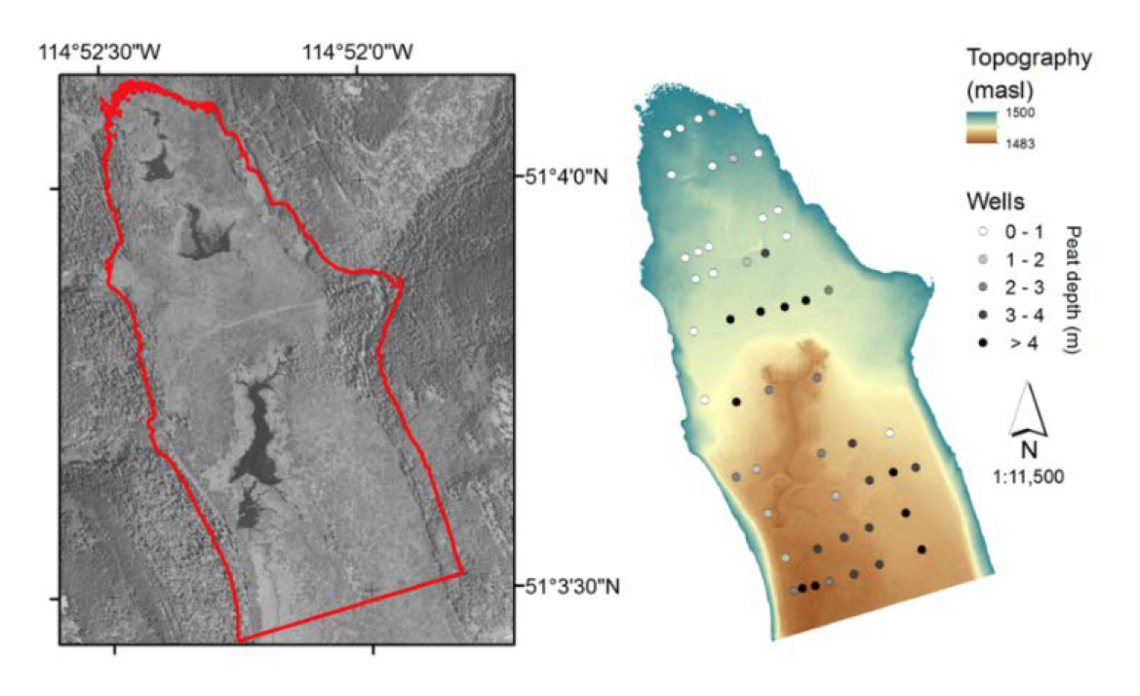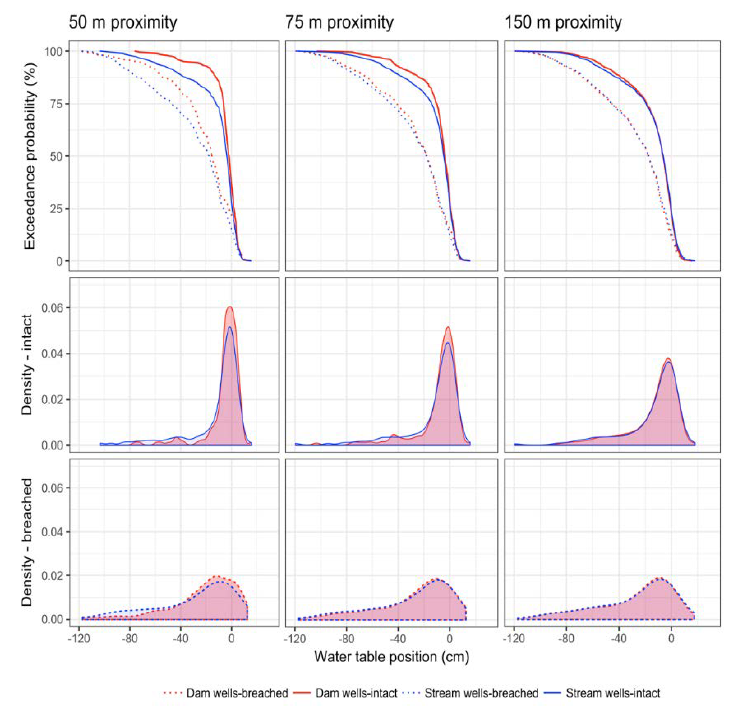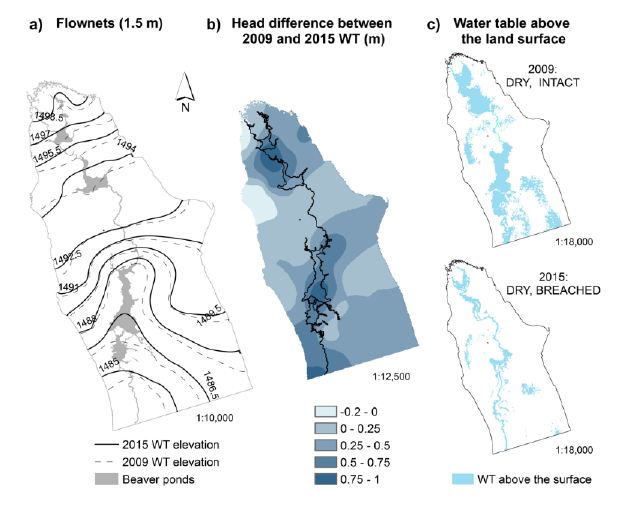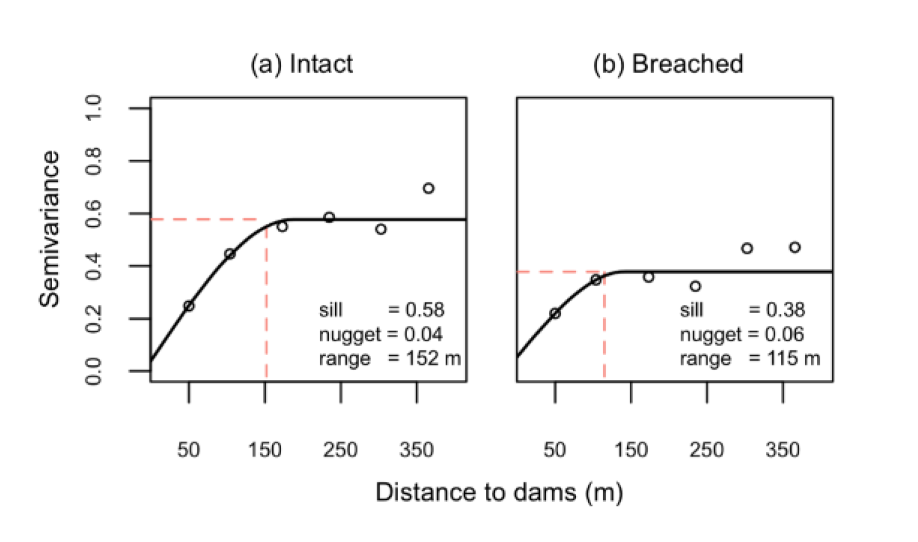Beaver-mediated water table dynamics in a montane peatland
Research Cluster: Ecohydrology, Groundwater and Watersheds
Project Coordinators: Daniel Karran, Cherie Westbrook, and Angela Bedard-Haughn, University of Saskatchewan
Note: The following research is a summary of results presented in Karran et al. (2017)
Introduction
Peatlands are one of the largest terrestrial carbon sinks in the biosphere (Loisel et al., 2017) because they form in areas where an excess of water creates high and stable water tables that inhibit the decomposition of organic matter produced locally. Plant community composition and the amount of carbon stored, depends largely on the dynamics of the water table dictated by a number of internal and external controls (Waddington et al., 2015). Some controls have been investigated extensively, whereas others, such as beaver, have not. Beaver (Castor canadensis) are well known for their ability to disrupt local hydrologic regimes and engineer ecosystems with the structures they build (Naiman et al., 1986). However, the bulk of this research has been focused in mineral soil environments, where water tables are typically much deeper than they are in peatlands. Thus, the goal of this study was to determine what impact beaver dams had on water tables dynamics in a Rocky Mountain fen at the peatland scale.

Fig.1: Satellite photo from August 8, 2008 of Sibbald Research Wetland (L) and digital elevation model of peatland (R) with the location of wells in the well network. Wells are shaded relative to the depth of the peat measured at each location.
Study location and methods
The setting for this study is the Sibbald Research Wetland, a rich flow-through fen in Kananaskis country, ~ 70 km west of Calgary (Fig. 1). Beaver have been very active in the peatland, maintaining a series of 15-20 beaver dams since at least the early 1950s, as evident in historic aerial photos. In 2006, a network of 50 shallow wells was installed in the basin and monitored weekly over the summer season of 2006-2009 (Fig. 1).
In June 2013, a major rain-on-snow flood event swept through the basin and breached many of the largest beaver dams, which had been intact for nearly 70 years. The well network was monitored again over the summers of 2014 and 2015 in order to have data sets with “intact” and “breached” beaver dams. Each year of well data was classified as either a wet or dry year based on a standardized precipitation index and then maps expressing water table stability and groundwater flow were created. Semivariogram models were created to test the regional dependency of water table stability in wells to beaver dams. Furthermore, wells were grouped based on their distance to beaver dams and the stream (to isolate the stream impacts on water tables), and analyzed for water table depth and stability using a variety of different statistical techniques (see Karran et al. 2017).
Results and discussion
We found that beaver dams can raise and stabilize water tables in peatland environments, even though they are already high. When the dams were intact, the median water table was on average 12.8 cm higher and more than twice as stable within a 150-m proximity. This was evident in the group distributions, where near proximity to intact dams produces a strong amplitude signal that nearly disappears when dams are breached (Fig. 2). Semivariograms models (Fig. 3) also showed a clear regional dependency between water table stability and beaver dams (that also dampens after dams breach).

Fig.2: Distributions of water table positions (cm) for the different groups of wells in the years with intact and breached beaver dams. Distributions expressed as exceedance probability curves (top) and density plots (middle and bottom).

Fig. 4: (a) Groundwater flow nets; (b) the difference in head between seasonal water tables; and (c) the spatial distribution of the seasonal water table that resides above the surface of the peatland during the driest years with intact and breached.

Fig.3: Spherical semivariogram models for water table stability using the distance to beaver dams as predictor variables, when the dams were (a) intact and (b) breached. The zone of influence boundary is denoted by the dashed red lines.
Groundwater maps show that beaver dams were focal areas for high hydraulic head and that they created flow patterns whereby streamflow was diverted away from the stream and into the peatland (Fig. 4). This was likely a result of the way beaver build dams in these environments; contrary to landscapes with mineral soils, peatland beaver dams resemble berms as they are built with excavated peat piled above the land surface. Relatively flat topography in peatlands allows dams to extend far beyond the stream channel, raising head over much larger areas and making the environment significantly wetter.
These findings have both hydrological and ecological implications. By raising and stabilizing water tables, beaver dams increase groundwater storage. This translates into more water available for baseflow, which is particularly important during times of drought (Hood & Bayley, 2008). Furthermore, by changing the peatland water table dynamics, beaver exert control on the plant assemblages that eventually become peat. Higher and more stable water tables may increase carbon sequestration in mountain peatlands (Chimner et al., 2002), enhancing peatland resiliency to climate change.
References
Chimner, R. a., Cooper, D. J., & Parton, W. J. (2002). Modeling carbon accumulation in Rocky Mountain fens. Wetlands, 22(1), 100–110. https://doi.org/10.1672/0277-5212(2002)022[0100:MCAIRM]2.0.CO;2
Hood, G. A., & Bayley, S. E. (2008). Beaver (Castor canadensis) mitigate the effects of climate on the area of open water in boreal wetlands in western Canada. Biological Conservation, 141(2), 556–567. https://doi.org/10.1016/j.biocon.2007.12.003
Karran, D. J., Westbrook, C. J., & Bedard-Haughn, A. (2017). Beaver-mediated water table dynamics in a Rocky Mountain fen. Ecohydrology, (October), e1923. https://doi.org/10.1002/eco.1923
Loisel, J., van Bellen, S., Pelletier, L., Talbot, J., Hugelius, G., Karran, D., … Holmquist, J. (2017). Insights and issues with estimating northern peatland carbon stocks and fluxes since the Last Glacial Maximum. Earth-Science Reviews, 165(February), 59–80. https://doi.org/10.1016/j.earscirev.2016.12.001
Naiman, R. J., Melillo, J. M., & Hobbie, J. E. (1986). Ecosystem alteration of boreal forest streams by beaver (Castor Canadensis). Ecology, 67(5), 1254–1269. Retrieved from http://www.jstor.org/stable/1938681
Waddington, J. M., Morris, P. J., Kettridge, N., Granath, G., Thompson, D. K., & Moore, P. a. (2015). Hydrological feedbacks in northern peatlands. Ecohydrology, 8(1), 113–127. https://doi.org/10.1002/eco.1493
